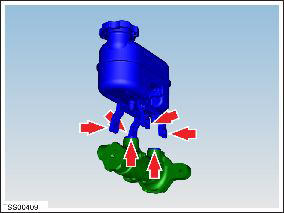Tesla Model S: Master Cylinder (Remove and Replace)
Tesla Model S (2012-2025) Service Manual / Brakes / Master Cylinder (Remove and Replace)
Note: This procedure applies to vehicles with the vacuum brake booster only. If the vehicle has the electromechanical brake booster assembly, the master cylinder is part of the brake booster assembly. Refer to procedure 33031402 (refer to procedure).
Removal
- Remove master cylinder and reservoir assembly (refer to procedure)
- Release reservoir to master cylinder fixing lugs (x4).
- Release reservoir from master cylinder connections (x2) and remove. Note: Place suitable absorbent material around the affected area to absorb any possible fluid spillage.
-
Remove and discard seals (x2) from master
cylinder.
Caution: Replace master cylinder seals.

- Installation procedure reverse of removal, except for the following: Warning: Only use cleaning agents and solvents in a well-ventilated area. Note: Clean the affected areas before installation.
- Bleed brakes (refer to procedure)
READ NEXT:
 Brake Hose - Flexible - Front - LH (Remove and Replace)
Brake Hose - Flexible - Front - LH (Remove and Replace)
Warning: If the vehicle
has air suspension, activate "Jack" mode on the touchscreen before
raising and supporting the vehicle.
Removal
Remove the front LH wheel
(refer
 Brake Hose - Flexible - Rear - LH (Remove and Replace)
Brake Hose - Flexible - Rear - LH (Remove and Replace)
Warning: If the vehicle
has air suspension, activate "Jack" mode on the touchscreen before
raising and supporting the vehicle.
Removal
Remove the rear wheel arch liner
 Bleed Procedure - One Caliper (Remove and Replace)
Bleed Procedure - One Caliper (Remove and Replace)
Warning:
If the 12V power supply is disconnected, do not attempt to open
any doors with door glass in closed position. Failure to follow
this instruction could result in door glass shat
SEE MORE:
 Fork and Control Link - Door - Exterior Handle - Rear - LH (Remove and
Replace)
Fork and Control Link - Door - Exterior Handle - Rear - LH (Remove and
Replace)
Removal
Remove Door Motor (refer to procedure)
Remove Door Grip (refer to procedure)
Remove press sensor screw.
Release door press sensor wiring connector.
Remove pivot pin connecting control link to PVT cartrid
 Link - Lower - Aft - LH (Remove and Replace)
Link - Lower - Aft - LH (Remove and Replace)
Warning: If the vehicle has air suspension, activate "Jack"
mode on the touchscreen before raising and supporting the vehicle.
Removal
Loosen the front LH lug nuts.
Raise and support the vehicle (refer to procedure)
Warning: Do not work on an incorrect
© 2019-2025 Copyright www.tesms.org

